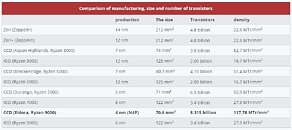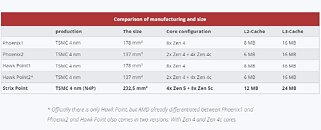- Joined
- Oct 9, 2007
- Messages
- 47,849 (7.39/day)
- Location
- Dublin, Ireland
| System Name | RBMK-1000 |
|---|---|
| Processor | AMD Ryzen 7 5700G |
| Motherboard | Gigabyte B550 AORUS Elite V2 |
| Cooling | DeepCool Gammax L240 V2 |
| Memory | 2x 16GB DDR4-3200 |
| Video Card(s) | Galax RTX 4070 Ti EX |
| Storage | Samsung 990 1TB |
| Display(s) | BenQ 1440p 60 Hz 27-inch |
| Case | Corsair Carbide 100R |
| Audio Device(s) | ASUS SupremeFX S1220A |
| Power Supply | Cooler Master MWE Gold 650W |
| Mouse | ASUS ROG Strix Impact |
| Keyboard | Gamdias Hermes E2 |
| Software | Windows 11 Pro |
AMD is about give the new "Zen 5" microarchitecture a near-simultaneous launch across both its client segments—desktop and mobile. The desktop front is held by the Ryzen 9000 "Granite Ridge" Socket AM5 processors; while Ryzen AI 300 "Strix Point" powers the company's crucial effort to capture Microsoft Copilot+ AI PC market share. We recently did a technical deep-dive on the two. HardwareLuxx.de scored two important bits of specs for both processors in its Q&A interaction with AMD—die sizes and transistor counts.
To begin with, "Strix Point" is a monolithic silicon, which is confirmed to be built on the TSMC N4P foundry node (4 nm). This is a slight upgrade over the N4 node that the company built its previous generation "Phoenix" and "Hawk Point" processors on. The "Strix Point" silicon measures 232.5 mm² in area, which is significantly larger than the 178 mm² of "Hawk Point" and "Phoenix." The added die area comes from there being 12 CPU cores instead of 8, and 16 iGPU compute units instead of 12; and a larger NPU. There are many other factors, such as the larger 24 MB CPU L3 cache; and the sizes of the "Zen 5" and "Zen 5c" cores themselves.


The "Granite Ridge" desktop processor is a chiplet-based processor, much like the Ryzen 7000 "Raphael." AMD is confirmed to be reusing the 6 nm client I/O die (cIOD) from "Raphael." This chip measures 122 mm², and packs 3.4 billion transistors. For reference, the cIOD of Ryzen 5000 "Vermeer" and Ryzen 3000 "Matisse" is built on the Global Foundries 12 nm node, measures a similar 125 mm², but with a much lower transistor count of 2.09 billion. The key contributor to the transistor count increase is the tiny iGPU that the Socket AM5 cIOD comes with. It may have just 1 workgroup processor (2 CU), but comes with the same display engines and media engines as the iGPU on APUs.
And now, onto the CPU complex dies (CCDs), the key area of silicon innovation for AMD desktop processors. The 8-core "Zen 5" CCD is codenamed "Eldora," and is built on the 4 nm foundry node. The HardwareLuxx.de report says that this the same N4P node as "Strix Point," but we've heard several other credible sources claiming that it is the more advanced N4X node, which favors high frequencies. The "Zen 5" CCD has a transistor count of 8.315 billion, which is a significant increase over the 6.5 billion of "Durango," the 8-core CCD based on "Zen 4," powering "Raphael."
What's most interesting is that this staggering 28% increase in transistor counts from the "Zen 4" Durango CCD to the "Zen 5" Eldora CCD comes at a die-area decrease of 0.5%. That's right, the "Zen 5" CCD measures 70.6 mm², whereas the "Zen 4" CCD is 71 mm². The "Zen 4" CCD is built on TSMC N5 (5 nm), which goes to show the leap in transistor densities achieved from the switch to N4P (or N4X).
A maxed out Ryzen 9 9950X processor hence has a total transistor count of 20.03 billion, while the single-CCD Ryzen 7 9700X has a transistor count of 11.715 billion.
AMD Ryzen 9000 series goes on sale from July 31, 2024.
View at TechPowerUp Main Site | Source
To begin with, "Strix Point" is a monolithic silicon, which is confirmed to be built on the TSMC N4P foundry node (4 nm). This is a slight upgrade over the N4 node that the company built its previous generation "Phoenix" and "Hawk Point" processors on. The "Strix Point" silicon measures 232.5 mm² in area, which is significantly larger than the 178 mm² of "Hawk Point" and "Phoenix." The added die area comes from there being 12 CPU cores instead of 8, and 16 iGPU compute units instead of 12; and a larger NPU. There are many other factors, such as the larger 24 MB CPU L3 cache; and the sizes of the "Zen 5" and "Zen 5c" cores themselves.


The "Granite Ridge" desktop processor is a chiplet-based processor, much like the Ryzen 7000 "Raphael." AMD is confirmed to be reusing the 6 nm client I/O die (cIOD) from "Raphael." This chip measures 122 mm², and packs 3.4 billion transistors. For reference, the cIOD of Ryzen 5000 "Vermeer" and Ryzen 3000 "Matisse" is built on the Global Foundries 12 nm node, measures a similar 125 mm², but with a much lower transistor count of 2.09 billion. The key contributor to the transistor count increase is the tiny iGPU that the Socket AM5 cIOD comes with. It may have just 1 workgroup processor (2 CU), but comes with the same display engines and media engines as the iGPU on APUs.
And now, onto the CPU complex dies (CCDs), the key area of silicon innovation for AMD desktop processors. The 8-core "Zen 5" CCD is codenamed "Eldora," and is built on the 4 nm foundry node. The HardwareLuxx.de report says that this the same N4P node as "Strix Point," but we've heard several other credible sources claiming that it is the more advanced N4X node, which favors high frequencies. The "Zen 5" CCD has a transistor count of 8.315 billion, which is a significant increase over the 6.5 billion of "Durango," the 8-core CCD based on "Zen 4," powering "Raphael."
What's most interesting is that this staggering 28% increase in transistor counts from the "Zen 4" Durango CCD to the "Zen 5" Eldora CCD comes at a die-area decrease of 0.5%. That's right, the "Zen 5" CCD measures 70.6 mm², whereas the "Zen 4" CCD is 71 mm². The "Zen 4" CCD is built on TSMC N5 (5 nm), which goes to show the leap in transistor densities achieved from the switch to N4P (or N4X).
A maxed out Ryzen 9 9950X processor hence has a total transistor count of 20.03 billion, while the single-CCD Ryzen 7 9700X has a transistor count of 11.715 billion.
AMD Ryzen 9000 series goes on sale from July 31, 2024.
View at TechPowerUp Main Site | Source




